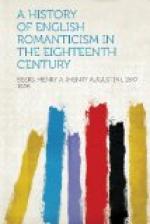Thus Chatterton’s sensitive genius was taking the impress of its environment. As he pored upon the antiquities of his native city, the idea of its life did sweetly creep into his study of imagination; and he gradually constructed for himself a picture of fifteenth-century Bristol, including a group of figures, partly historical and partly fabulous, all centering about Master William Canynge. Canynge was the rich Bristol merchant who founded or restored St. Mary Redcliffe’s; was several times mayor of the city in the reigns of Henry VI. and Edward IV., and once represented the borough in Parliament. Chatterton found or fabled that he at length took holy orders and became dean of Westbury College. About Canynge Chatterton arranged a number of dramatis personae, some of whose names he discovered in old records and documents, such as Carpenter, Bishop of Worcester, and Sir Theobald Gorges, a knight of Wraxhall, near Bristol; together with others entirely of his own invention—as John a Iscam, whom he represents to have been a canon of St. Augustine’s Abbey in Bristol; and especially one Thomas Rowley, parish priest of St. John’s, employed by Canynge to collect manuscripts and antiquities. He was his poet laureate and father confessor, and to him Chatterton ascribed most of the verses which pass under the general name of the Rowley poems. But Iscam was also a poet and Master Canynge himself sometimes burst into song. Samples of the Iscam and the Canynge muse diversify the collection. The great Bristol merchant was a mediaeval Maecenas, and at his house, “nempned the Red Lodge,” were played interludes—“Aella,” “Goddwyn,” and “The Parliament of Sprites”—composed by Rowley, or by Rowley and Iscam collaborating. Canynge sometimes wrote the prologues; and Rowley fed his patron with soft dedication and complimentary verses: “On Our Lady’s Church,” “Letter to the dygne Master Canynge,” “The Account of W. Canynges Feast,” etc. The well-known fifteenth-century poet Lydgate is also introduced into this literary cenacle, as John Ladgate, and made to exchange verse epistles with Rowley in eighteenth-century fashion. Such is the remarkable fiction which the marvelous boy erected, as a scaffolding for the fabric of sham-antique poetry and prose, which he build up during the years 1767 to 1770, i.e., from the fifteenth to the eighteenth year of his age.
There is a wide distance between the achievements of this untaught lad of humble birth and narrow opportunities, and the works of the great Sir Walter, with his matured powers and his stores of solid antiquarian lore. But the impulse that conducted them to their not dissimilar tasks was the same. In “Yarrow Revisited,” Wordsworth uses, a propos of Scott, the expression “localized romance.” It was, indeed, the absorbing local feeling of Scott, his patriotism, his family pride, his attachment to the soil, that brought passion and poetry into his historical pursuits.




